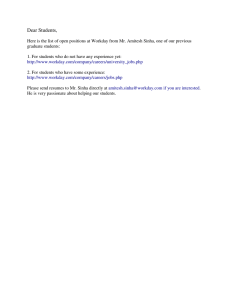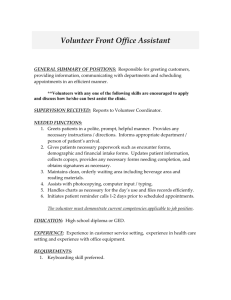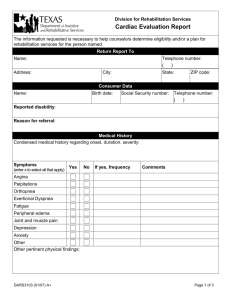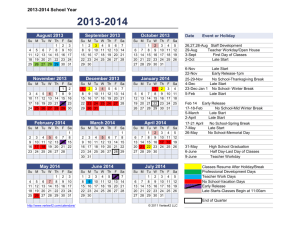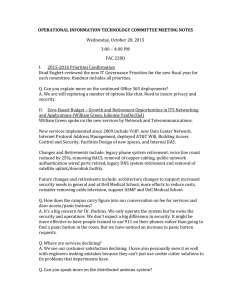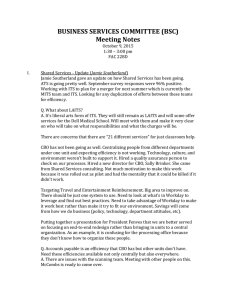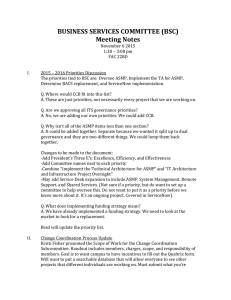STRATEGIC IT ACCOUNTABILITY BOARD AGENDA Friday, January 15, 2016 STARK LIBRARY MAI 400
advertisement
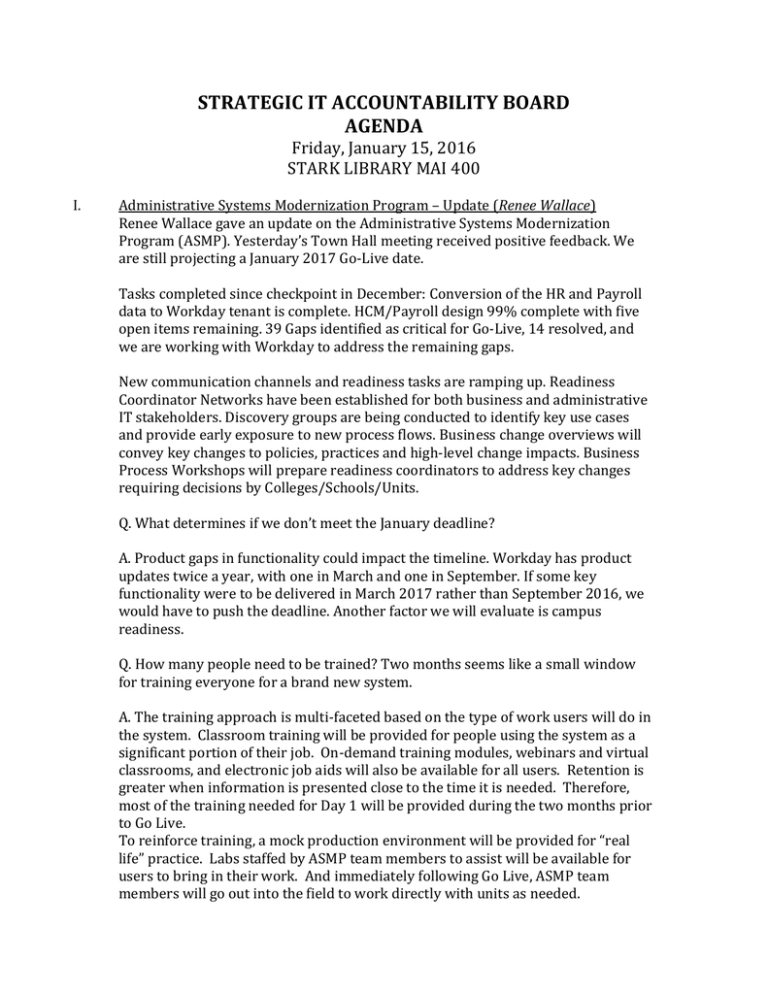
STRATEGIC IT ACCOUNTABILITY BOARD AGENDA Friday, January 15, 2016 STARK LIBRARY MAI 400 I. Administrative Systems Modernization Program – Update (Renee Wallace) Renee Wallace gave an update on the Administrative Systems Modernization Program (ASMP). Yesterday’s Town Hall meeting received positive feedback. We are still projecting a January 2017 Go-Live date. Tasks completed since checkpoint in December: Conversion of the HR and Payroll data to Workday tenant is complete. HCM/Payroll design 99% complete with five open items remaining. 39 Gaps identified as critical for Go-Live, 14 resolved, and we are working with Workday to address the remaining gaps. New communication channels and readiness tasks are ramping up. Readiness Coordinator Networks have been established for both business and administrative IT stakeholders. Discovery groups are being conducted to identify key use cases and provide early exposure to new process flows. Business change overviews will convey key changes to policies, practices and high-level change impacts. Business Process Workshops will prepare readiness coordinators to address key changes requiring decisions by Colleges/Schools/Units. Q. What determines if we don’t meet the January deadline? A. Product gaps in functionality could impact the timeline. Workday has product updates twice a year, with one in March and one in September. If some key functionality were to be delivered in March 2017 rather than September 2016, we would have to push the deadline. Another factor we will evaluate is campus readiness. Q. How many people need to be trained? Two months seems like a small window for training everyone for a brand new system. A. The training approach is multi-faceted based on the type of work users will do in the system. Classroom training will be provided for people using the system as a significant portion of their job. On-demand training modules, webinars and virtual classrooms, and electronic job aids will also be available for all users. Retention is greater when information is presented close to the time it is needed. Therefore, most of the training needed for Day 1 will be provided during the two months prior to Go Live. To reinforce training, a mock production environment will be provided for “real life” practice. Labs staffed by ASMP team members to assist will be available for users to bring in their work. And immediately following Go Live, ASMP team members will go out into the field to work directly with units as needed. Q. Is this a late January Go Live date? A. The specific date will be determined later. Q. What about the sponsored project functionality? A. Grants management is part of Workday Financials. It is a less mature part of the financials product and several functionality gaps have been identified. We are working with the Workday product team to design solutions and determine which releases will include the critical gaps related to grants. Q. How stable is your staff? A. We are fairly stable but have had turnover. Some recent open positions have been slow to fill. Q. Will you have two sets of data? One in Legacy and one in Workday? A. Historical information will be loaded to the Institutional Data Store (IDS). The Enterprise Data Management team is mapping legacy data to Workday data, and both will be available in the IDS to ensure continuity and facilitate year over year reporting. As part of the cutover to Workday, there will be a brief period where only critical transactions will be processed and they will have to be entered in both the legacy system and in Workday. II. Identity and Access Management – Update (C.W. Belcher) C.W. Belcher gave an update on the Identity and Access Management (IAM) roadmap and highlights. In 2014, Toopher was implemented to provide two-factor authentication. With the purchase of Toopher by Salesforce last year and subsequent freeze on Toopher development, Duo Security has been selected to replace Toopher. Duo has a proven track record in higher education and will provide a better user experience than Toopher. The transition from Toopher to Duo will occur in stages from March to July 2016. Access to W-2s will continue to be protected by Toopher until after the spring tax filing season. We also will be selecting a Lightweight Authentication solution soon. Lightweight Authentication has been a long-standing need for many units such as the Development Office, Human Resources Services, and Athletics. This solution will enable constituents to use social identity accounts or email-based accounts to access services targeted to loosely affiliated groups. The Request For Proposals is currently in process, and we are planning for an implementation in the fall. We are starting the three-phase roll-out of the SailPoint IdentityIQ IAM solution, and we have selected KPMG for implementation assistance. SailPoint will provide role-based authorization management that will allow system access to be granted more efficiently, reducing the effort required to manage authorizations as employees join, leave, or move within the University. Q. Can users continue using the EID option after lightweight authentication is available? A. Yes. Q. What is the scope of SailPoint? A. SailPoint will allow us to support group and role-based authorizations and will allow us to replace our current aging custom-developed identity administration and password management system. Q. What about different levels of security for computing devices? A. We are working to establish a more flexible identity assurance framework for campus. Currently we use a one-size-fits-all framework. The new framework will allow us to balance user convenience with the need to maintain security and meet state-mandated regulations that require us to know who is accessing computer resources. III. VoIP Cost Savings – Update (William Green) William Green presented the VoIP cost savings update which was requested in the last SITAB meeting. The handout includes a snapshot of what telephone billing was in Fiscal Year (FY) 2011-2012 and estimated billing for FY 2016-2017. ITS is now billing $2.2M less for phones every year. At the outset, projections showed there would be no saving unless units reduced their phone usage. And they did. Removals of 10% removal been estimated, but units ended up removing closer to 25% of phones. This is where the savings come from. The old telephone rates had been subsidized the Building Access Control System (BACS). Governance asked that the subsidy be ended and rates be established. Even with the new BACS rates, Colleges/Schools/Units are paying less. Annual campus-wide savings from VoIP is about $1.6 million. Q. Looks like every unit saved. Are there concerns with under-provisioning of security? A. We are working with committees within IT Governance and Campus Safety & Security to be sure there are appropriate levels of building security in place. Standards are defined in the operations manual requiring certain levels. Removals during remediation require approvals of Campus Safety & Security.
